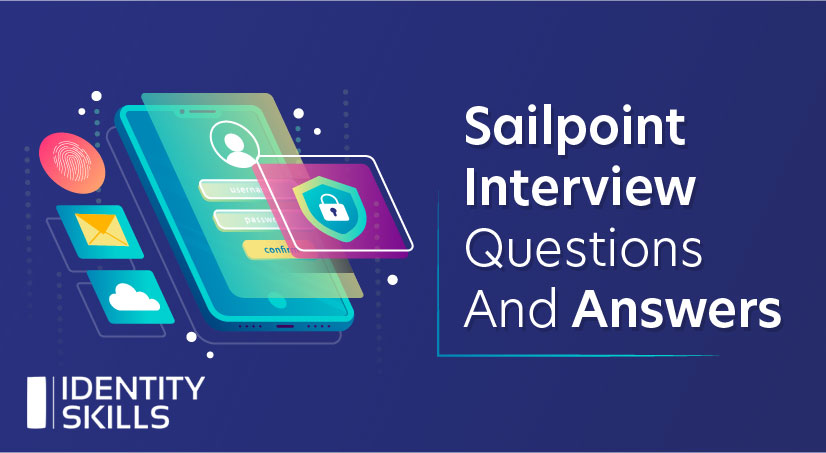1. What is Sailpoint?
SailPoint is an open-source identity governance platform that gives organizations of all sizes the power to create an identity-enabled enterprise by combining data, devices, and applications.
2. What is a Governance Platform?
A governance Platform is one that supports the centralization of identity data, business policy, risk modeling, and roles for supporting user lifecycle and compliance initiatives.
3. What are the different modules for SailPoint?
IdentityIQ Compliance Manager
The Compliance Manager Module of SailPoint IIQ can allow organizations to improve compliance and audit performance with cost-effectiveness.
- Business-friendly Access Certifications.
- Automated Policy Management.
- Audit Reporting and Analytics.
IdentityIQ Lifecycle Manager
The IdentityIQ Lifecycle Manager Module of SailPoint IIQ can allow organizations to deliver a business-oriented solution to access securely and cost-effectively.
- Self-Service Access Request.
- Automated Provisioning.
IdentityIQ Password Manager
The IdentityIQ Password Manager Module of SailPoint IIQ can allow organizations to create a simple solution for managing user passwords and reducing operational costs and boosting productivity.
- Self-Service Password Management.
- Strong Password Policy Enforcement and Sync.
The IdentityIQ Governance Platform
It creates a foundation for effective risk management by centralizing identity data and providing a single place to model roles, policies, risks, and business processes.
4. What is the Audit Configuration?
The audit Configuration page on Sailpoint helps in specifying actions collected for different audit logs. The system administrator has to specify actions subjected to audit because of the impact of collecting and storing even information in audit logs on performance. Prior to the collection of any data by audit logs for use in audit search, the configuration of IdentityIQ for auditing is mandatory.
5. What is the Identity Warehouse?
The Identity Warehouse is at the core of the Governance Platform serving as the central repository for identity and access data across all enterprise IT applications in the data center and the cloud. The warehouse is populated by importing user data from any authoritative source (e.g., HRMS) and user account and entitlement data from business applications, databases, platforms, and other systems. It is designed to scale and rapidly import access data from large numbers of applications and users by leveraging out-of-the-box connectors or via flat files.
6. What are the Provisioning Integration Modules?
SailPoint recognizes that many organizations have significant investments in legacy provisioning systems. To maximize existing investments in these systems, IdentityIQ can leverage existing connectivity through alternative provisioning systems to connect to enterprise resources and pull user account data into its Identity Warehouse to support compliance and identity lifecycle management activities. IdentityIQ can also be configured to push changes resulting from day-to-day identity business processes down to the provisioning solution to implement account changes in target IT systems. SailPoint offers Provisioning Integration Modules (PIMs) for numerous legacy user provisioning solutions, including BMC Identity Manager, IBM Tivoli Identity Manager, Novell Identity Manager, Oracle Identity Manager, and Sun Identity Manager (Oracle Waveset).
7. How to Create a Service Account Using Simple Mapping?
A>.ClickAdd New Attributeor click an existing attribute to display the Edit Account Attribute page
B>. Enter or change the attribute name and an intuitive display name.
Note: You cannot define an extended attribute with the same name as an application attribute that is provided by a connector
C>.ClickAdd Source to display the Add a source dialog and specify a source for the new attribute.
D>. Specify the following values:
Attribute Name — service
Display Name — Service Account
Edit Mode — Read Only
Attribute Type — boolean
Searchable — Read Only
Multi‐Valued — this is not a multi‐valued attribute so do not select this field.
E>. Click Add Source Mapping to display the Add a source to the attribute dialog.
F>. Map the attribute:
Select Application Attribute.
Then Select DB Application from the Application drop‐down list.
Select Service from the Attribute drop‐down list.
G>. Click Add.
8. Define Application onboarding.
The complete procedure of confirming the availability, and getting the client information from applications into the Sailpoint IIQ is called Application onboarding.
9. What is the application of SailPoint?
SailPoint Identity is a robust and feature-rich, cloud-based identity governance arrangement that conveys password management, provisioning, access control, and request, and access accreditation administrations for cloud, tablets, mobiles, and on-premises applications
10. Define Application onboarding.
The complete procedure of confirming the availability, and getting the client information from applications into the Sailpoint IIQ is called Application onboarding.
11. What is the application of SailPoint?
SailPoint Identity is a robust and feature-rich, cloud-based identity governance arrangement that conveys password management, provisioning, access control, and request, and access accreditation administrations for cloud, tablets, mobiles, and on-premises applications
These are some of the basic Sailpoint questions and answers by our expert for sailpoint training and placement

